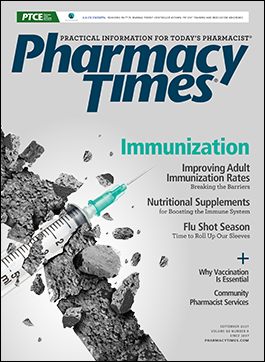Publication
Article
Pharmacy Times
Case Studies (September 2017)
Author(s):
What should these pharmacists do?
CASE 1
JM is a 25-year-old male presenting to his primary care physician with complaints of pain upon urination, urethral discharge, and erythema. JM states that he began to experience these symptoms several days after having unprotected sex with his new girlfriend. Cultures confirm a diagnosis of gonorrhea. JM now comes to you with a prescription for azithromycin 500 mg (2 tablets by mouth for one day) and a single dose of ceftriaxone 250mg intramuscular injection. JM asks you why he needs to take both medications and why his provider recommended that his girlfriend be treated as well. JM is otherwise healthy and does not take any medications or OTC products .
What recommendations would you provide to JM?
CASE 2
FG is a 21-year-old female who, for the past several days, has complaints of frothy, odorous, yellowish vaginal discharge. In addition to these symptoms, FG also states she has experienced increased vaginal redness and itching. FG is currently sexually active with her boyfriend of 8 months who “at times will choose to not use a condom.” FG has never experienced these symptoms before, nor does she have a history of any sexually transmitted infections. After FG visits a local walk-in clinic, it is determined that she has trichomoniasis. The treating physician is not sure of the best antibiotic to use for this infection, so they ask you, as FG’s pharmacist, for a recommendation. In addition, FG expresses to you that she recently lost her job and is concerned about how much treatment will cost. FG does not have any other medical conditions; her medication list includes a daily dual hormone oral contraceptive and a multivitamin.
How would you recommend that FG be treated?
SEE THE ANSWERS BELOW
ANSWERS
CASE 1: Current World Health Organization guidelines recommend dual antimicrobial therapy when treating gonorrhea due to the high rate of co-infection with chlamydia. While gonorrhea strains of bacteria have become increasingly resistant to penicillin and fluoroquinolone antibiotics, they remain largely susceptible to 3rd generation cephalosporins such as ceftriaxone. Additionally, chlamydia species are susceptible to azithromycin. Treatment of JM’s sexual partner is recommended in order to reduce the risk of reinfection post-treatment. As the pharmacist, you should advise JM to take both tablets of azithromycin at the same time and to avoid contaminant use of aluminum or magnesium containing antacids, as this may reduce the drugs absorption. Furthermore, inform JM that he may experience gastrointestinal symptoms such as flatulence, diarrhea, or cramping, as azithromycin is a pro-motility agent. JM should be instructed to receive the ceftriaxone injection at the same time as taking the azithromycin, though he should also be told that ceftriaxone used in combination with azithromycin may cause increased propensity.
CASE 2: Standard treatment for trichomoniasis is either a single 2 gram dose of metronidazole or a single 2 gram does of tinidazole. Similar to other sexually transmitted infections, it is recommended to treat the sexual partner with the same dose in order to prevent reinfection. Metronidazole tends to be less costly and should be recommended for FG. FG should be counseled to avoid alcohol and alcohol-containing mouthwashes for at least 3 days following treatment with metronidazole, as this medication can cause a disulfiram-type reaction. FG may experience nausea, diarrhea, or dizziness at first, and should be advised to avoid activities that require mental alertness or coordination until drug effects are realized. You should also explain to FG that it is common for patients to experience a metallic taste in their mouths from metronidazole and that this is a normal, transient side effect. Additionally, FG should be advised to look for signs of peripheral neuropathy and to discontinue taking the medication immediately if such symptoms arise.
Dr. Caranfa is a medical student at the University of Connecticut School of Medicine in Farmington, Connecticut.Dr. Kohn is a senior scientist at the University of Connecticut and Hartford Hospital Evidence-Based Practice Center in Hartford, Connecticut.Dr. Coleman is a professor at University of Connecticut School of Pharmacy, Storrs, Connecticut.







